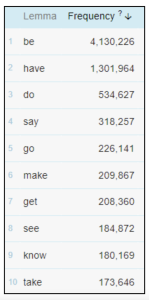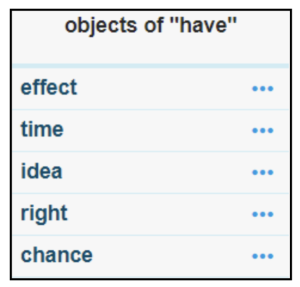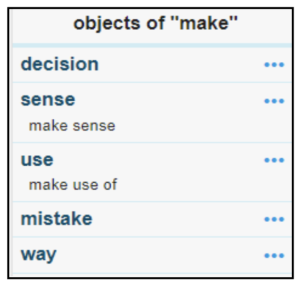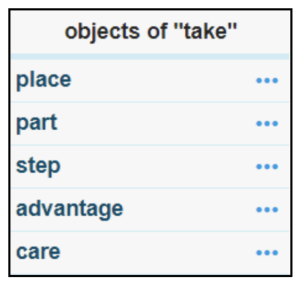15. Using the BNC to explore the use of “have”, “make” and “take”
Deborah Veronese Fritsch; Marcela Carvalho; Rita De Leeuw; and Maria Eduarda Santos do Livramento
Deborah Veronese Fritsch
Undergraduate student at Federal University of Rio Grande do Sul
Marcela Carvalho
Undergraduate student at Federal University of Rio Grande do Sul
Rita De Leeuw
Undergraduate student at Montclair State University
Maria Eduarda Santos do Livramento
Undergraduate student at Federal University of Rio Grande do Sul
Goals: To teach students how to use the main verbs “make”, “take” and “have” and observe their differences in various contexts.
Audience: Beginner English learners (Middle school students to adults)
Duration: 40-45 minutes
INTRODUCTION
The main verbs “make”, “take” and “have” are among the most common verbs used in the English language. Given their frequent use in English, it is important for English learners to know how and when they should be used. In this chapter, we will examine the use of these three verbs using the British National Corpus (BNC) on Sketch Engine. The goal of this chapter is to give students and teachers alike insight on the contextual and grammatical use of these verbs.
STEP 1: CORPUS ANALYSIS
In Sketch Engine, the Word List function can be used to find the frequency of the verbs in the BNC. Using this function, we can see that “have” is the second most common verb (1,301,964 occurrences) in the BNC, “make” is the 6th (209,867 occurrences) and “take” is the 10th (173,646 occurrences).

Figure 1 – Frequency of verbs in the British National Corpus (BNC) via Sketch Engine
The Concordance function and “Frequency of text types” features were used to find in which contexts each verb is most frequent. It is possible to observe that the verbs are more frequently found in written contexts, especially in books and periodicals. However, while the second context where “have” and “take” are most used is spoken English, “make” is more common in written contexts, which will be our main focus for this class plan. Finally, the Word Sketch tool can be used to discover which words occur most frequently with the verbs.

Figure 2 – Word Sketch feature results for “have”
The nouns “effect”, “time”, “idea”, “right” and “chance” are the most frequently used nouns with the main verb “have”. After searching for phrase examples in the Concordance feature, we noticed that the nouns and the modifiers give a different meaning to the verb and that some of the nouns require specific prepositions. A common structure used with the verb is Subject + have + noun / noun + preposition. Examples of this formation can be found below:
- The agreement will have little effect on Mexico’s debt (influence on something);
- I’m having a marvelous time” (enjoy something);
- We had no idea what they were looking for (think about something);
- Individuals have the right to demand protection (have social and political rights or authority);
- You had the chance to do it (get an opportunity).

Figure 3 – Word Sketch feature results for “make”
The search on Sketch Engine also showed that the most common words used with the verb “make” are the nouns “decision”, “sense”, “use”, “mistake” and “way”. In the examples presented below, each word gives a different meaning to the verb and some of the nouns require specific prepositions as well. It should also be noted that modifiers such as adverbs also influence the verb. Subject + make + noun / noun + preposition is a common grammatical structure used with the verb.
- All the decisions made by the next Labour government will be vetted. (decide about something);
- Most of the conversation at mealtimes made little sense to (have a clear meaning);
- Scientists are now making use of the black widow spider’s venom. (use something);
- We all have to accept that each of us has made mistakes in the past. (do something wrong);
- By eight o’clock, Lindsey made her way to the hospital. (to move to a particular place).

Figure 4 – Word Sketch feature results for “take”
Lastly, if following these steps with students, the teacher might want to point out that the most common words used with the verb “take” are the nouns “place”, “part”, “step”, “advantage” and “care”. The phrase examples below show the same result as the other verbs: each collocate gives a different meaning to the verb and some of them require specific prepositions. Therefore, Subject + take + noun / noun + preposition is a common grammatical construction used with the verb.
- When will this party take place? (something will happen or has happened);
- It is a pity that the United States has felt unable to take part in the agreement. (participate);
- I didn’t take a step from home at all today. (stay at the same place all day);
- My friend is a surf instructor and is visiting for a few days. Let’s take advantage and learn to surf! . (benefit someone or something)
- I’m going to take care of (help someone).
STEP 2: PRACTICE ACTIVITIES
After working through the previous steps in class with the students, we suggest giving students a chance to practice with the following exercises. These exercises were created based on the corpus analysis.
Exercise #1 – The verbs “make,” “take,” and “have” are some of the most common English language verbs, in part because they are highly versatile, occurring in many expressions that are used in everyday life. Fill in the blanks with one of these three verbs, based on the expression that is used in each sentence.
- The father may be staying around to _______ care of the other kids. (BLOG)
- I have to sell some of my dolls to _______ room for new ones. (BLOG)
- It was a moment before she could _______ sense of what had happened. (FIC)
- I didn’t _______ a problem with the engine room design. (BLOG)
- On Sunday, the cabinet meeting will _______ place. (SPOK)
- The idea is to _______ fun, not win medals. (MAG)
- We move at a slow pace, rather than act quickly and _______ a mistake to the detriment of the game. (NEWS)
- These countries were trying to _______ advantage of higher oil prices. (MAG)
Exercise #2 – This exercise has incomplete sentences extracted from fiction books and periodicals. Use the verb have only to fill in the blanks of the sentences that require it as a main verb. After filling in the blanks, it is necessary to identify what meaning the main verb is expressing by putting the letter or the sentence in the space of the meaning. Pay attention to the form of the verb that needs to be used.
- When we say that individuals _______ a right to be protected against assault, we do not mean that this protection must be achieved through some particular scheme we already have in mind. The community as a whole has a duty to provide adequate protection in some way. (Periodical Law’s Empire)
- They _______ come to the conclusion that, from the point of view of the welfare of the children, it is more important to the children that they should not be separated from each other. (Periodical The Weekly Law Report)
- They talked for ages, making each other laugh, finding shared points of view, generally _____ a good time. (Book Sudden fire, by Elizabeth Oldfield)
- Where Matthew was, Sara _______ no idea. Perhaps he was with the group by the lake, or the others under the trees. (Book The divided house, by Mary Raymond)
- She continues her interest in Old English studies kindled by J. R. R. Tolkien and ______ added Old Welsh. (Periodical Report & Supplement)
- Rachel searched her memory to ask something about one of his latest records, but before she ________ the chance to say anything Belinda said, ‘Is David your boyfriend?’ ‘No, Belinda,’ Rachel answered quickly. (Book False impressions, by Lucy Keane)
- The gradual drying out of the levels is also ________ an effect on the local flora. (Periodical The Environment Digest)
- She had to resign her Fellowship at Somerville, where she _______ taught biochemists for over twenty years. (Periodical Report & Supplement)
( ) get an opportunity ( ) have social and political right
( ) think about something ( ) influence on something
( ) enjoy something
Exercise #3 – Fill in the blanks with the verbs “make” or “take”, paying attention to which verb should be used and the respective form of the verb as well. After filling in the blanks, identify the objects by underlining them, and in some cases, the prepositions as well, related to the verb.
Example: Most decisions made by individuals, organizations and administrators involve some degree of risk or uncertainty about the outcome. (grant abstract)
- Since the early 1960s, considerable debate has ______ place in educational circles about the nature of history as a discipline.
- Agents will always be _____ mistakes, and some agents will be _____ larger mistakes than others. (Book Involuntary Unemployment, by James Trevithick)
- The department could look at the value of _____ use of the local environment as a resource for its teaching. (Book Studies in school self-evaluation, by Desmond Nuttal)
- While _____ care of people from other countries, we must make sure that we can help the people who were born here.
- Executives from all local real estate offices _____ part in the mayor’s symposium on development.
- She tried to _____ sense of it while he parted her hair neatly on either side of her neck. (Book Goshawk squadron, by Derek Robinson)
- He will respond the very moment you ______ a step of faith. Do not think given up now, just keep going.
- She was _____ her way to the Chester’s stand, sunk in thought, when the familiar sandy-haired man loomed in front of her. (Book Love by design, by Rosalie Ash)
- I ______ advantage of my business trip to New York and stayed a few extra days to see the sights and enjoy the city.
Carvalho, M., De Leeuw, R., Eduarda Santos do Livramento, M., & Veronese Fritsch, D. (2023). Using the BNC to explore the use of “have”, “make” and “take”. In L. Goulart & I. Veloso (Eds). Corpora in English Language Teaching: Classroom Activities for Teachers New to Corpus Linguistics. Open Educational Resource. Montclair State University.
